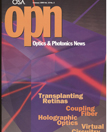
February 1999 Issue
- Retinal Transplantation: Will Blind Patients with Retinitis Pigmentosa be Able to See Again?
- Shimmering Holograms in Semiconductor Heterostructures: Current Trends in Self-Adaptive Holographic Ooptics
- Shedding Light on Hybrid Optics: A Tutorial in Coupling
- Light Guiding Light: Letting Light Be the Master of Its Own Destiny
- Linear Optical Vortices
- Ultrafast Normal Lens for 35-mm Rangefinder Camera
- Optics Kits For Kids
- Browse all Issues
Feature Articles
Retinal Transplantation: Will Blind Patients with Retinitis Pigmentosa be Able to See Again?
Manuel del Cerro will give the Smith-Kettlewell Lecture at the Vision Science and Its Applications Topical Meeting this month. In this article based on his talk, he and his coauthors describe retinitis pigmentosa and explain how retinal transplantation might lead to better sight for those suffering from this disease.
by Vamsi K. Gullapalli, Coca Del Cerro, Manuel Del CerroShimmering Holograms in Semiconductor Heterostructures: Current Trends in Self-Adaptive Holographic Ooptics
Nolte explains the properties of dynamic holographic (thin) films, and discusses varied potential uses, including as video holographic imaging through turbid media, as adaptive ultrasound detectors, and as ultrafast pulse shapers.
by David D. NolteShedding Light on Hybrid Optics: A Tutorial in Coupling
In most fiber optic systems, optical fiber and waveguides are coupled to and from bulk optical devices, creating hybrid optical devices. In this tutorial article, the authors explain in detail how to successfully collimate, focus, and align hybrid optics, including polarizing and polarization maintaining optics.
by Garland Best, Omur M. SezermanLight Guiding Light: Letting Light Be the Master of Its Own Destiny
Spatial solitons—not to be confused with their temporal cousins—may provide a means to all-optical circuitry. This article looks at their unique properties and prophesies what might be possible using this technology.
by Allan W. Snyder and François LadouceurLinear Optical Vortices
An optical vortex is a phase singularity nested within the cross-sectional profile of a coherent beam of light. Such vortices occur naturally in the electromagnetic mode structure of certain optical cavities. They may also be created artificially by computer-generated holograms designed to impart to an incident beam of light the desired phase/amplitude characteristics of a vortex. In recent years, the study of vortices has become the focus of several research groups around the world, as potential applications have emerged. Noteworthy examples of such applications are the manipulation of small objects by optical tweezers and the control of atomic/molecular beams via the exchange of angular momentum with optical vortices.
by Masud Mansuripur and Ewan M. WrightUltrafast Normal Lens for 35-mm Rangefinder Camera
This month's design is a modification of the familiar double-Gauss design that has a very weak thick element and a negative field flattener located close to the image plane. In addition to the unusual field group, the design uses three aspheric surfaces to achieve extremely good imaging performance at an aperture of f/1. The correction of oblique spherical aberration is particularly noteworthy, as this is the aberration that limits the performance of all conventional wide-aperture double-Gauss designs.
by J. Brian CaldwellOptics Kits For Kids
Take a look at any good-sized science museum gift shop, or toy or educational store, and you'll find many science kits for kids. Judging from the number and diversity of kits vying for attention, one can conclude that there's money to be made satisfying parents' desires to provide their children with some good clean science fun. There are chemistry sets, electronics experiment boxes, geology and fossil kits, do-it-yourself dissection kits (with preserved worms!), magnetism kits, and kits to teach astronomy, ecology, and—of course— optics.
by Michael E. Knotts
![Infinity Mirrored Room– Brilliance of the Souls 2014 by artist Yayoi Kusama. [© YAYOI KUSAMA]](https://opnmedia.blob.core.windows.net/$web/opn/media/images/articles/2024/0724/departments/202407-cover-web.jpg?ext=.jpg)
![An experimental scheme demonstrated by researchers at Princeton and Yale universities, USA, can convert physical noise into errors that can be corrected more easily. [F. Wojciechowski, Princeton University]](https://opnmedia.blob.core.windows.net/$web/opn/media/images/articles/2024/0624/departments/202406-cover-web.jpg?ext=.jpg)
